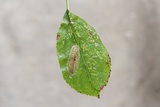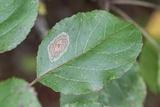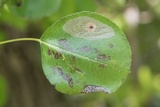Phyllonorycter corylifoliella (Hübner, 1796) Species
Last modified: Dec. 10, 2025, 4:47 p.m.
A rather common species throughout Belgium.
Details
- Classification
- Family: Gracillariidae > Subfamily: Lithocolletinae > Genus: Phyllonorycter > Species: Phyllonorycter corylifoliella
- Vernacular names
- Vruchtboomvouwmot (NL), Hawthorn midget (EN), Braune Weißdorn-Miniermotte (DE)
- Synonyms
- Phyllonorycter betulae (Zeller, 1839)
- First mention in Belgium
- Fologne E. 1859b. Supplément au catalogue des lépidoptères de Belgique. — Annales de la Société entomologique belge 3: 133–142. On page 141. view page
- Status
-
Native
Distribution
Imago
Head brown, mixed with white hairs. Forewing brown, one yellowish white stria in the middle of the costa and a similar, but slightly longer stria at the middle of the inner margin; a long curved, whitish basal line.
Museum specimens
No pictures yet!Specimens in nature
No pictures yet!Caterpillar
Greenish yellow with a brown head capsule.
Mine
At first just a small silvery line with a central brown line, on top of a leaf vein. Later a white, whitish grey or silvery, semi-circular or oval, tentiform mine on the upperside of a leaf, most of the time on the central vein or a strongly developed side vein. In the beginning without no longitudinal folds, but later with quite some folds making the leaf curl upwards. The frass is scattered all over the leaf, contrary to the situation in Phyllonorycter leucographella, which occurs partly on the same host plants, where the frass is concentrated.
This species has a very complicated mining behavior. In the first tentiform, epidermal mine, a second, smaller mine is constructed in the palisade parenchyma. After feeding for a while in this second mine, the caterpillar consumes the roof of that small mine and just a central, black patch remains.
See also gracillariidae.net and bladmineerders.be.
Bionomics
It pupates inside the mine and the pupa hibernates. The adults are mainly active at dusk and come to light.
Flight periods
The adults fly in two generations a year from late April till June, and again in August.
Observed on
The larva lives in a mine of various Rosaceous trees, especially on Malus, Crataegus, Pyrus and Sorbus.
Especially in N Europe, mines have been found on Betula, but in our country it is very rarely found. Also very rarely on Fagus.










